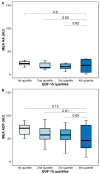Growth Differentiation Factor-15 Correlates Inversely with Protease-Activated Receptor-1-Mediated Platelet Reactivity in Patients with Left Ventricular Assist Devices
- PMID: 35455481
- PMCID: PMC9031879
- DOI: 10.3390/ph15040484
Growth Differentiation Factor-15 Correlates Inversely with Protease-Activated Receptor-1-Mediated Platelet Reactivity in Patients with Left Ventricular Assist Devices
Abstract
Growth differentiation factor (GDF)-15 inhibits platelet activation, prevents thrombus formation, and has been linked to bleeding events. This was a prospective study including 51 left-ventricular assist device (LVAD) patients on aspirin and phenprocoumon. Platelet surface expression of activated glycoprotein (GP) IIb/IIIa was assessed by flow cytometry, and platelet aggregation was measured by multiple electrode aggregometry (MEA) in response to arachidonic acid (AA), adenosine diphosphate (ADP), and thrombin receptor-activating peptide (TRAP), a protease-activated-receptor-1 (PAR-1) agonist. GDF-15 was determined with a commercially-available assay. There was a trend towards an inverse correlation of GDF-15 with activated GPIIb/IIIa in response to TRAP (r = -0.275, p = 0.0532) but not in response to AA and ADP. Moreover, GDF-15 correlated with MEA TRAP (r = -0.326, p = 0.0194), whereas it did not correlate with MEA ADP and MEA AA. In a second step, GDF-15 levels in the fourth quartile were defined as high GDF-15. Patients with high GDF-15 showed significantly lower TRAP-inducible platelet aggregation by MEA compared to patients in the first quartile (63 AU vs. 113 AU, p = 0.0065). In conclusion, in LVAD patients receiving state-of-the-art antithrombotic therapy, GDF-15 correlates inversely with residual platelet reactivity via PAR-1.
Keywords: GDF-15; GPIIb/IIIa; LVAD; PAR-1; multiple electrode aggregometry.
Conflict of interest statement
D.W. is a consultant and proctor for Abbott and Medtronic. D.Z. receives research grants from Abbott and Medtronic, is an advisory board member for Abbott, Medtronic, and Berlin Heart, and is a proctor for Abbott and Medtronic. The other authors have no conflict of interest to declare.
Figures








Similar articles
-
Growth Differentiation Factor 15 Is Associated with Platelet Reactivity in Patients with Acute Coronary Syndrome.J Clin Med. 2023 Feb 17;12(4):1627. doi: 10.3390/jcm12041627. J Clin Med. 2023. PMID: 36836162 Free PMC article.
-
Comparison of Aggregometry with Flow Cytometry for the Assessment of Agonists´-Induced Platelet Reactivity in Patients on Dual Antiplatelet Therapy.PLoS One. 2015 Jun 9;10(6):e0129666. doi: 10.1371/journal.pone.0129666. eCollection 2015. PLoS One. 2015. PMID: 26058047 Free PMC article.
-
Response to antiplatelet therapy and platelet reactivity to thrombin receptor activating peptide-6 in cardiovascular interventions: Differences between peripheral and coronary angioplasty.Atherosclerosis. 2014 Jan;232(1):119-24. doi: 10.1016/j.atherosclerosis.2013.10.027. Epub 2013 Nov 10. Atherosclerosis. 2014. PMID: 24401225
-
Novel antithrombotic drugs in development.Drugs. 1995 Jun;49(6):856-84. doi: 10.2165/00003495-199549060-00002. Drugs. 1995. PMID: 7641602 Review.
-
Understanding the mechanism of platelet thrombus formation under blood flow conditions and the effect of new antiplatelet agents.Curr Vasc Pharmacol. 2004 Jan;2(1):23-32. doi: 10.2174/1570161043476456. Curr Vasc Pharmacol. 2004. PMID: 15320830 Review.
Cited by
-
Cellular and Molecular Mechanisms Activated by a Left Ventricular Assist Device.Int J Mol Sci. 2023 Dec 24;25(1):288. doi: 10.3390/ijms25010288. Int J Mol Sci. 2023. PMID: 38203459 Free PMC article. Review.
-
Platelet reactivity is associated with pump thrombosis in patients with left ventricular assist devices.Res Pract Thromb Haemost. 2024 Sep 5;8(6):102564. doi: 10.1016/j.rpth.2024.102564. eCollection 2024 Aug. Res Pract Thromb Haemost. 2024. PMID: 39391561 Free PMC article.
-
Growth Differentiation Factor-15 and Clinical Outcomes in Japanese Patients With Ischemic Heart Disease.JACC Asia. 2023 May 9;3(3):457-471. doi: 10.1016/j.jacasi.2023.03.008. eCollection 2023 Jun. JACC Asia. 2023. PMID: 37396418 Free PMC article.
-
Growth Differentiation Factor 15 Is Associated with Platelet Reactivity in Patients with Acute Coronary Syndrome.J Clin Med. 2023 Feb 17;12(4):1627. doi: 10.3390/jcm12041627. J Clin Med. 2023. PMID: 36836162 Free PMC article.
References
-
- Maltais S., Kilic A., Nathan S., Keebler M., Emani S., Ransom J., Katz J.N., Sheridan B., Brieke A., Egnaczyk G., et al. PREVENtion of HeartMate II Pump Thrombosis Through Clinical Management: The PREVENT Multi-Center Study. J. Heart Lung Transplant. 2017;36:1–12. doi: 10.1016/j.healun.2016.10.001. - DOI - PubMed
-
- Potapov E.V., Antonides C., Crespo-Leiro M.G., Combes A., Färber G., Hannan M.M., Kukucka M., De Jonge N., Loforte A., Lund L.H., et al. 2019 EACTS Expert Consensus on Long-Term Mechanical Circulatory Support. Eur. J. Cardio Thorac. Surg. 2019;56:230–270. doi: 10.1093/ejcts/ezz098. - DOI - PMC - PubMed
-
- Bootcov M.R., Bauskin A.R., Valenzuela S.M., Moore A.G., Bansal M., He X.Y., Zhang H.P., Donnellan M., Mahler S., Pryor K., et al. MIC-1, a Novel Macrophage Inhibitory Cytokine, Is a Divergent Member of the TGF-β Superfamily. Proc. Natl. Acad. Sci. USA. 1997;94:11514–11519. doi: 10.1073/pnas.94.21.11514. - DOI - PMC - PubMed
-
- Farhan S., Freynhofer M.K., Brozovic I., Bruno V., Vogel B., Tentzeris I., Baumgartner-Parzer S., Huber K., Kautzky-Willer A. Determinants of Growth Differentiation Factor 15 in Patients with Stable and Acute Coronary Artery Disease. A Prospective Observational Study. Cardiovasc. Diabetol. 2016;15:60. doi: 10.1186/s12933-016-0375-8. - DOI - PMC - PubMed
Grants and funding
LinkOut - more resources
Full Text Sources

